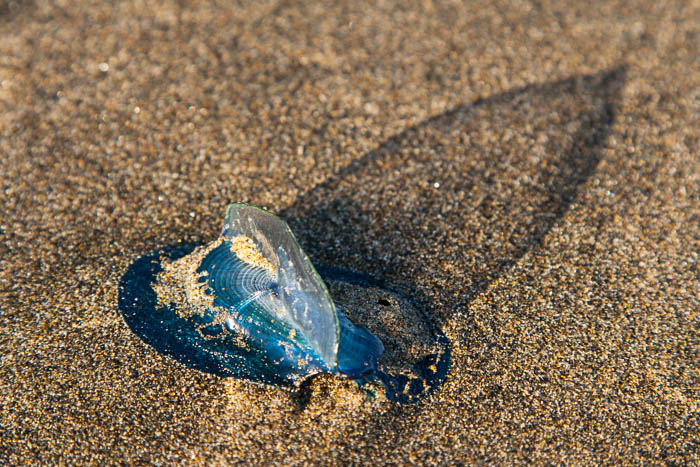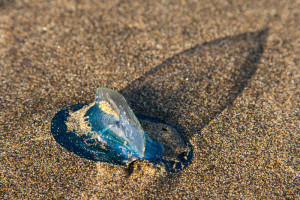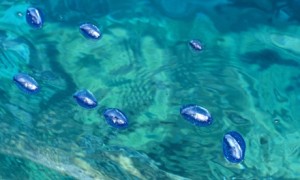Society member, Geoff Mower, recently sent us a message as follows: –
“A few years ago I was travelling in New Zealand, and wandered in the late afternoon along Keri-Keri Beach, just north of Auckland. Keri-Keri is one of NZ’s well-known black sand beaches, and is worth visiting for that reason alone. If you need another reason, this is the beach where Jane Campion’s “The Piano” was filmed. Anyway, what I found were thousands of cast up sails of Velella velella, the By-the-Wind-Sailor, another floating colonial jellyfish, although not as vicious as the Portuguese man o’war! They had been there a little while, and all of the soft parts had largely shrivelled away, leaving just the slightly more substantial back plates and sails. I have attached a picture for your interest.”
By-the-Wind-Sailor, Velella velella
(Taken by Geoff Mower)
Further details regarding Velella velella are to be found at The Guardian, as follows: –
US west coast awash in millions of jellyfish-like Velella velella
Known as by-the-wind-sailors, the creatures regularly cluster offshore each spring and are not poisonous to most people.
(Photo: Alamy)
The animals are in fact colonies of much smaller creatures known as hydrozoans that cluster together to form a gleaming purple body.
Millions of jellyfish-like creatures have washed up on beaches along the US west coast over the past month, giving the shoreline a purple gleam and, at times, an unpleasant odor, ocean experts said on Thursday.
Though not poisonous to most people, beach-goers should avoid the animals because their venom can cause stinging in the eyes and mouth, said Steve Rumrill, an expert at the Oregon Department of Fish and Wildlife.
Known as Velella velella to scientists, and more informally as “by-the-wind sailors,” the creatures regularly cluster offshore each spring. But it is unusual for so many to wash ashore at once, especially this late in the summer, he said.
In addition to the millions that have been spotted on beaches from Southern California to Washington, millions more are floating near the ocean surface offshore, Rumrill added.
Ocean experts do not know why more by-the-wind sailors are washing up this year, or why they are arriving later than usual, said Erin Paxton, spokeswoman for the Oregon Coast Aquarium.
Climate change may be a factor, but it is impossible to be certain, Rumrill said. “This is a wind-driven event, and winds are unusual this year,” he said.
Though most people think the animals are jellyfish, they are in fact colonies of much smaller creatures known as hydrozoans, Rumrill said.
Hundreds of tiny organisms cluster together to create a gleaming purple body and a translucent sail-like protrusion that looks like a single animal.”
There are several comments below the above posting, comments such as “Used to see “hordes of the things” on a regular basis on the west coast of Ireland in the 1980’s and 1990’s and indeed more recently. Always reminded me of miniature versions of the Portuguese man O’ War, but without the nasty sting!”




Very interesting article Steve and well done for following up the details re ID etc-Dave M